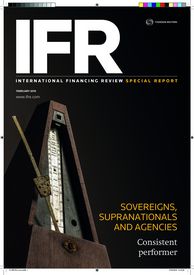Squeezed bank dealers quit EGB markets
The number of banks reviewing their primary dealership commitments is on the rise as they weigh up the costs versus the returns, leading to questions over liquidity and pricing.

Consistent performer: A little over a year into the European Central Bank’s quantitative easing programme and the dust is finally beginning to settle.
To purchase printed copies or a PDF of this report, please email leonie.welss@lseg.com and shahid.hamid@lseg.com
The number of banks reviewing their primary dealership commitments is on the rise as they weigh up the costs versus the returns, leading to questions over liquidity and pricing.
Borrowers have learned some hard lessons from the onset of European QE as they attempt to remain relevant with historic investors while navigating ECB-induced distortions.
The discussion regarding the relative merits of euros versus US dollars has created a rollercoaster ride that looks set to continue in a market that both confounds and confuses.
Investors are operating against a backdrop of considerable global economic uncertainty, with sentiment squeezed on one side by the slowdown in China and on the other by rising rates in the US. But although the year has started off with volatility across asset classes, investors feel the SSA sector is well supported and is healthier than it has been for some years.
Negative interest rates and QE in Europe undoubtedly support eurozone government bonds but there is a price to pay, either in terms of a new issue premium or – more worryingly – the potential longer term health of the economy.
Finland’s Municipality Finance last year became the first SSA issuer to raise its leverage ratio by issuing AT1 capital, but it may not be the preferred option for other agencies.
If history is bunk, as Henry Ford once intimated, then what of the ancient art of predicting the rate of inflation?
Debt issuance from sub-Saharan Africa has slumped thanks to high-profile questions of impropriety and the commodity crisis. But the fundamentals have not really changed.
While a waning Asian bid has dampened appetite for Australian dollar paper, its neighbour across the Tasman Sea is picking up some of the slack.
China’s municipal bond market has the potential to become one of the world’s largest, with the figure touted around by analysts for total outstanding issuance being up to Rmb10trn (US$1.5trn). But recent tepid demand shows that the market’s development will be challenging.